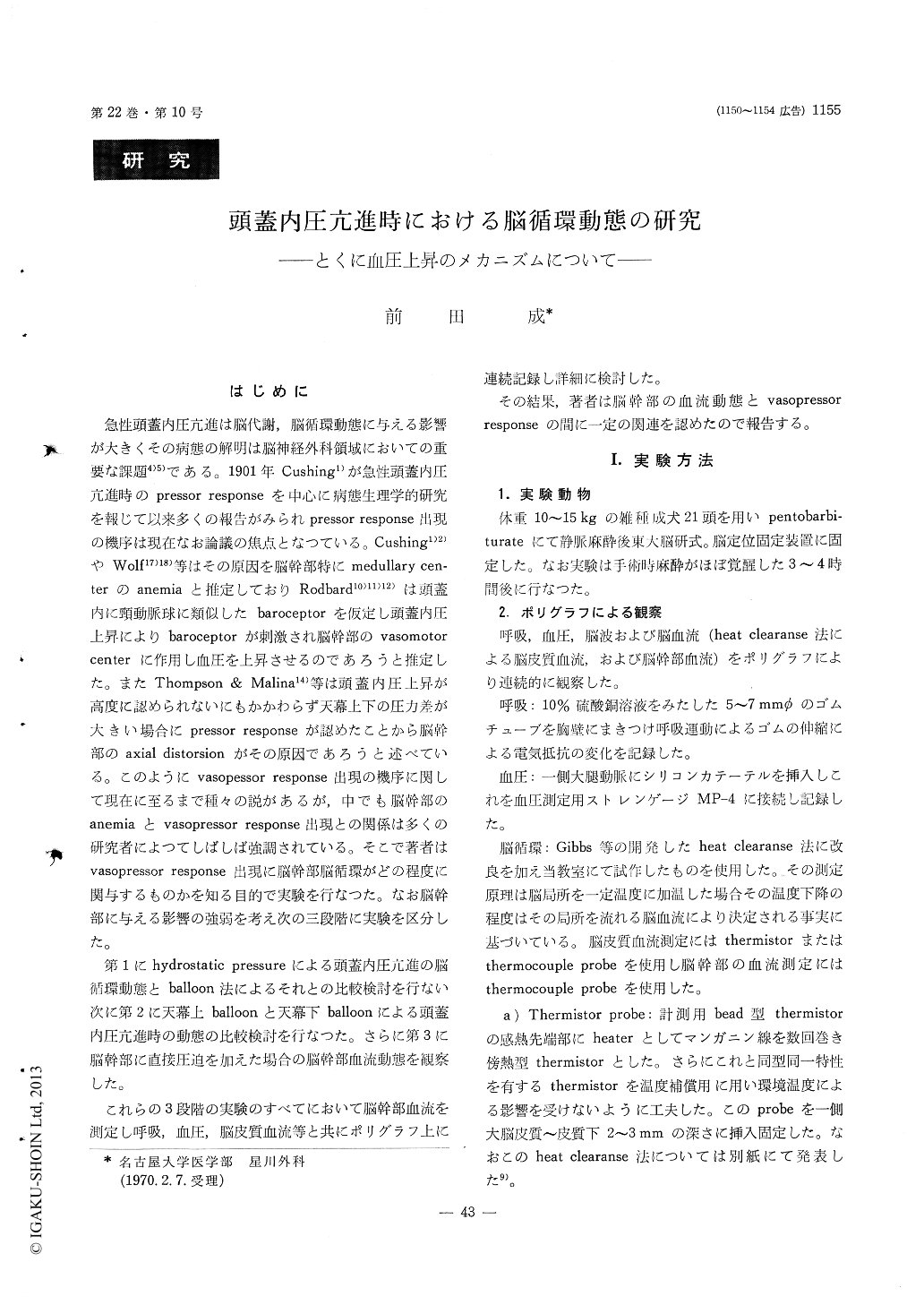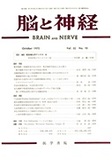Japanese
English
- 有料閲覧
- Abstract 文献概要
- 1ページ目 Look Inside
はじめに
急性頭蓋内圧亢進は脳代謝,脳循環動態に与える影響が大きくその病態の解明は脳神経外科領域においての重要な課題4)5)である。1901年Cushing1)が急性頭蓋内圧亢進時のpressor responseを中心に病態生理学的研究を報じて以来多くの報告がみられpressor response出現の機序は現在なお論議の焦点となっている。Cushing1)2)やWolf17)18)等はその原因を脳幹部特にmedullary cen—terのanemiaと推定しておりRodbard10)11)12)は頭蓋内に頸動脈球に類似したbaroceptorを仮定し頭蓋内圧上昇によりbaroceptorが刺激され脳幹部のvasomotor centerに作用し血圧を上昇させるのであろうと推定した。またThompson & Malina14)等は頭蓋内圧上昇が高度に認められないにもかかわらず天幕上下の圧力差が大きい場合にpressor responseが認めたことから脳幹部のaxial distorsionがその原因であろうと述べている。このようにvasopessor response出現の機序に関して現在に至るまで種々の説があるが,中でも脳幹部のanemiaとvasopressor response出現との関係は多くの研究者によってしばしば強調されている。そこで著者はvasopressor response出現に脳幹部脳循環がどの程度に関与するものかを知る目的で実験を行なった。なお脳幹部に与える影響の強弱を考え次の三段階に実験を区分した。
第1にhydrostatic pressureによる頭蓋内圧亢進の脳循環動態とballoon法によるそれとの比較検討を行ない次に第2に天幕上balloonと天幕下balloonによる頭蓋内圧亢進時の動態の比較検討を行なった。さらに第3に脳幹部に直接圧迫を加えた場合の脳幹部血流動態を観察した。
Considerable works have been performed to study the mechanism of vasopressor response produced by the increased intracranial pressure. Among these, anemia in the brain stem is widely accepted as one of the most probable mechanism. In this paper, the effects of increased intracranial pressure on cerebral blood flow, especially in the brain stem, were studied in 21 dogs. Serial recordings of respiration, systemic blood pressure, cerebral blood flow through the cere-bral cortex and the brain stem, intracranial pressure and EEG were performed on a polygraph during acute intracranial hypertension produedc by hydro-static pressure or by expansion of a balloon placed in the supra or infratentorial space.
When the intracranial pressure is slowly elevated (at a pressure increment of 100 mm. of water per min.) by the application of hydrostatic pressure, it was observed that arterial hypertension produced by the vasopressor response was proceeded by decrease in blood flow through the brain stem. In order to investigate further the above result, a balloon was introduced into the epidural space over the frontal lobe through a burr hole. In this case, a fall in the cortical blood flow as well as suppression of the electrical activity was observed in earlier experimen-tal course than the case of hydrostatic method. In either method, the vasopressor response was proce-eded by decrease in blood flow through the brain stem.
When an infratentorial balloon was inflated (0. 25 cc per 2 min.) slowly, the vasopressor response ap-peared with a sudden decrease in blood flow through the brain stem in a few minutes following the in-flation. Cerebral blood flow through the cortex and electrical activity were maintained until a final stage. As can be expected, the infratentorial balloon effected the brain stem more directly than the su-pratentorial balloon.
In order to produce a condition in which pressure was applied only on the brain stem, a steel bar with a blunt head was applied to the brain stem. There was a fall of blood flow in the brain stem followed by arterial hypertension.
From the above mentioned experiment, if can be concluded that anemia in the brain stem is one of the most important factors for inducing the vaso-pressor response.

Copyright © 1970, Igaku-Shoin Ltd. All rights reserved.


